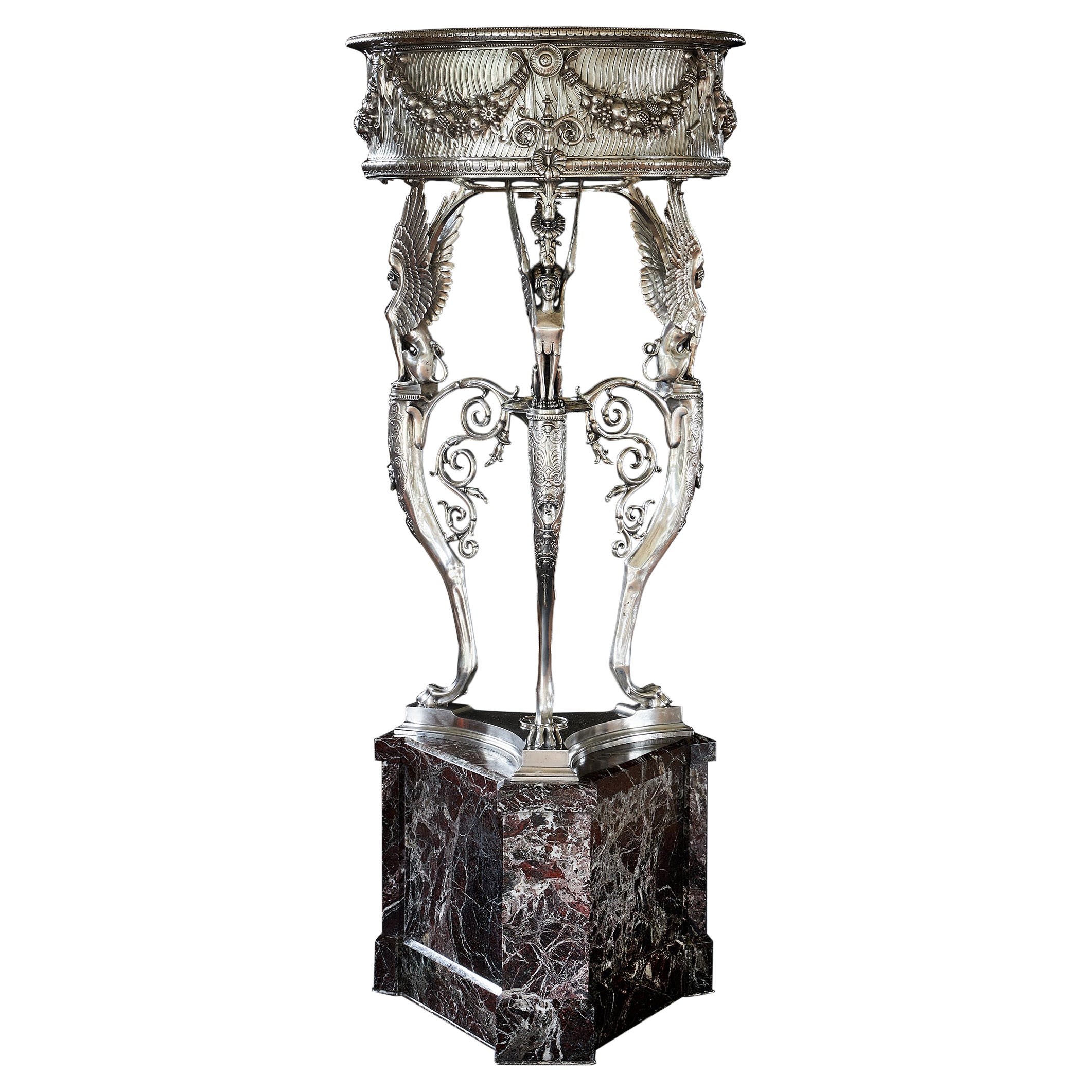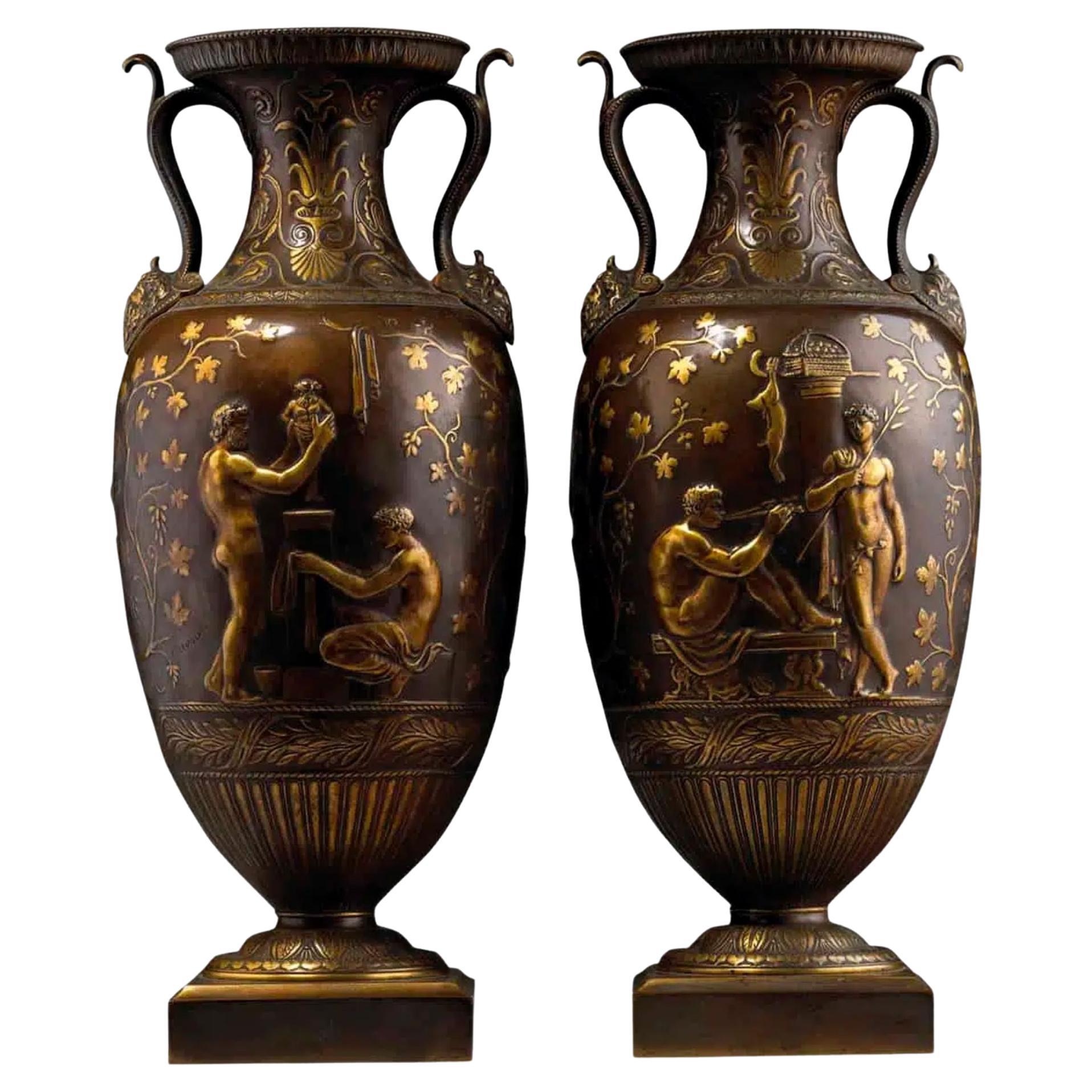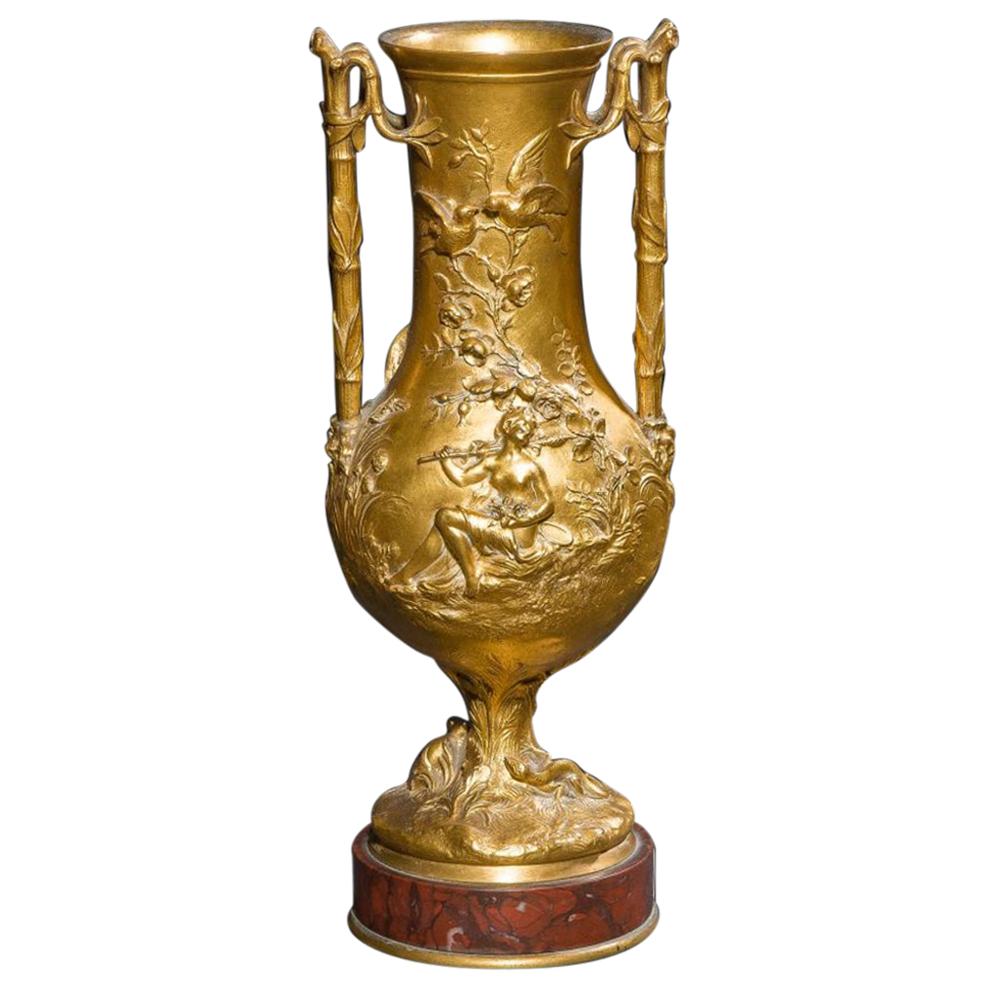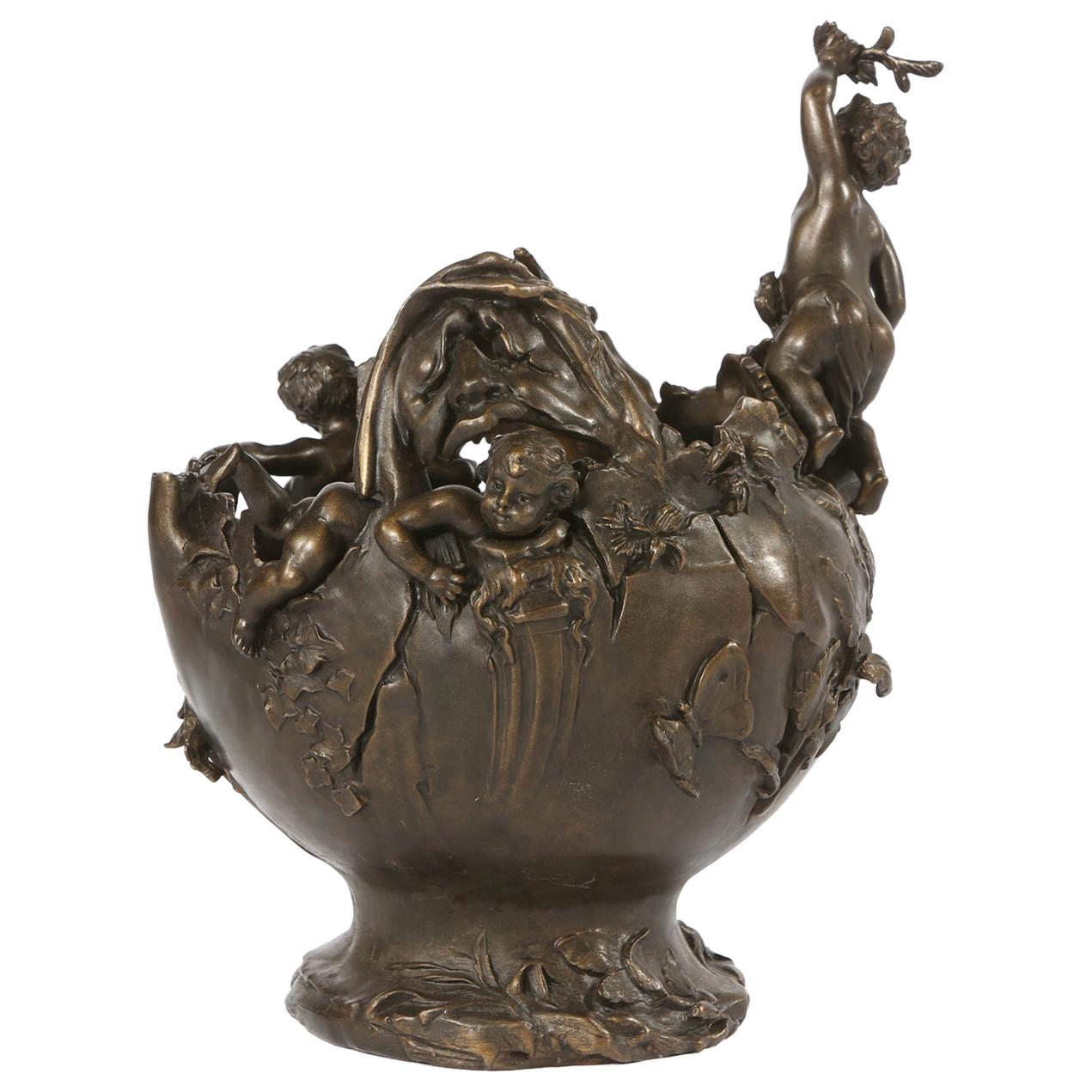Early 20th Century Gilt Bronze "Decorative Vases" by Ferdinand Barbedienne
About the Item
- Creator:Ferdinand Barbedienne (Workshop/Studio)
- Dimensions:Height: 9.85 in (25 cm)Width: 0 in (0.01 mm)Depth: 0 in (0.01 mm)
- Style:Art Nouveau (Of the Period)
- Materials and Techniques:
- Place of Origin:
- Period:
- Date of Manufacture:1900
- Condition:Wear consistent with age and use.
- Seller Location:London, GB
- Reference Number:
Ferdinand Barbedienne
Founded by one-time Parisian wallpaper dealer Ferdinand Barbedienne and engineer Achille Collas, one of the most revered foundries in 19th-century France began with the invention of a revolutionary 1830s-era device that could produce proportional reproductions — large or small — of sculptures. Collas’s machine, which yielded miniature likenesses of antiquities for the interiors of homes the world over, was pivotal to the success of the F. Barbedienne Foundry. The successful firm earned prestigious awards and critical acclaim and created exquisite bronze candleholders, clocks and lamps for a range of wealthy and prominent clients.
The duo first launched their company under the name Société Collas et Barbedienne, and early on, they optimized chemical processes for pigmenting and patinating their bronze statuettes. After Collas died in 1859, Barbedienne forged on alone, and the company’s name changed to simply F. Barbedienne.
Barbedienne employed more than 300 workers at that point, and the Maison created a range of furnishings and decorative objects that featured the integration of marble and ormolu accents. However, with the onset of the Franco-Prussian War of 1870, the foundry was forced to retrofit its molds, and the production of cannons replaced sculptures, furniture and vases.
When Ferdinand Barbedienne passed away in 1891, his nephew and heir, Gustave Leblanc, took over as president, changing the name to Leblanc-Barbedienne. Leblanc expanded production into Germany, the United Kingdom and the United States, carrying on the company's legacy with monumental sculptures, and models and securing production rights for famous statues. Paul-Alexandre Dumas, an Art Nouveau maker and student of Louis Majorelle, succeeded Leblanc until the company's closing in 1952.
Barbedienne pieces had been exhibited regularly in the 19th century and were especially prevalent at Europe’s international expositions and world’s fairs, where they received numerous prizes. Today, the Musée d’Orsay in Paris holds dozens of Barbedienne works in its collection, including intricate mirrors, vases and cups created by Louis-Constant Sévin at the foundry. For more than two decades, Sévin created lamps, boxes and more at Maison Barbedienne. Working alongside award-winning chaser Désiré Attarge, Sévin designed Napoleon III-era works that greatly appealed to European nobility.
Other notable artists who collaborated with Barbedienne included Eugene Aizelin, Emmanuel Fremiet, Antonin Mercié, Emile Guillemin, Edouard Lievre, Ferdinand Levillain and Auguste Rodin.
On 1stDibs, find a collection of antique Ferdinand Barbedienne decorative objects, lighting and more.
- ShippingRetrieving quote...Ships From: London, United Kingdom
- Return PolicyA return for this item may be initiated within 10 days of delivery.
- Early-20th Century Bronze Vase Entitled "Fée des Bois" by Charles KorschannBy Charles KorschannLocated in London, GBA very beautiful late 19th Century French Art Nouveau bronze vase decorated with two gilt bronze female figures sitting upon a tree stump. The surface of the vase with excellent detail and very fine colour, signed Korschann and with foundry mark for Louchet Paris Additional information Height: 15 cm Condition: Excellent Original Condition Circa: 1900 Materials: Bronze Foundry: Louchet Paris About Charles Korschann Biography Charles Korschann (1872-1943). Born in Brno in Moravia, he attended the Fine Arts Academies in Vienna and Berlin. Although he frequently returned to Moravia, then part of the Austro-Hungarian Empire but a constituent part of Czecho-Slovakia after the First World War, he spent most of his life after 1894 in Paris. He designed many small mostly Art Nouveau subjects including vases, inkwells, clocks, lamps, wall sconces, and jardinières among those with some utility, often with full figures of elegant women, nearly always with hieratic expressions or Symbolist poses. He exhibited at the Salons of the Société des Artistes Français from 1894 to 1905, and was awarded a Bronze Medal at the 1900 Exposition Universelle. He worked with gilt and patinated bronze, bronze with polychrome glazed and unglazed ceramics...Category
Early 20th Century French Art Nouveau Figurative Sculptures
MaterialsBronze
- Early 20th Century Cameo Vase Entitled "Moon Vase" by Emile GalléBy Emile GalléLocated in London, GBA beautiful early 20th Century cameo glass vase acid cut and etched with a deep red floral decoration against a yellow background. With a crescent moon at the openning of the vase. E...Category
Early 20th Century French Art Nouveau Vases
MaterialsGlass
- Early 20th Century Cameo Glass "Rosehips Vase" by Daum FreresBy DaumLocated in London, GBAn attractive late 19th Century cameo glass vase with fruiting cotoneaster plant against a variegated background with excellent colour and fine detail, signed Daum Nancy with the Cro...Category
Early 20th Century French Art Nouveau Vases
MaterialsGlass
- Early 20th Century Cameo Glass "Cyclamen Vase" by Daum FrèresBy DaumLocated in London, GBA very pretty early 20th Century cabinet cameo glass vase enamel painted with pink and purple cyclamen flowers against a white & pink field, Signed Daum Nancy with the Cross of Lorra...Category
Early 20th Century French Art Nouveau Vases
MaterialsGlass
- Early 20th Century Art Nouveau Glass Vase "Landscape Vase" by Emile GalléBy Emile GalléLocated in London, GBA spectacular late 19th Century French cameo glass vase of Art Nouveau form with layered colours of deep purple, blue, green and yellow depicting a lake amidst a tree lined landscape...Category
Early 20th Century French Art Nouveau Vases
MaterialsGlass
- Early 20th Century Cameo Glass Vase entitled "Hellebore Vase" by Daum FrèresBy DaumLocated in London, GBAn intricate cameo glass vase etched and enamelled with pink hellebore floral decoration against a white field highlighted with gilding. The vase exhibiting very fine colour and deta...Category
20th Century French Art Nouveau Vases
MaterialsGlass
- 19th Century Silvered Bronze Athénienne Jardinière by Ferdinand BarbedienneBy Ferdinand BarbedienneLocated in Oxfordshire, United KingdomA French silvered-bronze athénienne by Ferdinand Barbedienne, Paris, last quarter 19th century with a revolving liner, the frieze applied with bucrania suspending ribbon-tied berried laurel swags above a border of bellflowers on a stippled ground above three seated female sphinxes issuing stylised foliage and scrolls on lion monopodia cast with the mask of Hercules, scrolling foliage and anthemions joined by stretchers, raised on a concave-sided triform marble base on a further thin silvered-bronze base, inscribed to the tripod base 'F. BARBEDIENNE' Measures: 103.3cm. high, 41.5cm. diameter; 3ft. 4 3/8 in, 1ft. 4 1/4. This impressive athénienne is a key reminder of the longevity of a particular model and design’s success from Antiquity through to the 19th century and up until this day. Typically known as the ‘Trépied du Temple d’Isis’, this athénienne is designed after the Roman antique originally found at Pompeii and now at the Museo Archeologico Nazionale, Naples (fig.1). From being for example an inspiration for the baptismal font of Napoléon’s son in 1811, this model was the inspiration to many highly skilled makers throughout the 19thcentury such as the Manfredini brothers from Milan and of course the Parisian well-established bronze founder Ferdinand Barbedienne who executed the present example. The Temple of Isis was a Roman temple dedicated to the Egyptian goddess Isis and was among one of the first discoveries during the excavation of Pompeii in 1764. Certainly considered as one of the most elegant examples of antique tripods, the existence of this model was then popularized to the rest of Europe via prints, one of the first being by Giovanni Battista Piranesi in 1779. This type of tripod was also popularised by an engraving in C. Percier and P. Fontaine’s, Receuil de Décorations Intérieures of 1801. Interestingly, there is also a watercolour now in the Musée Carnavalet, Paris, showing this type of tripod displayed at the 1801 Exposition des Produits de L’Industrie in the Louvre. The passion for Greek and Roman Art in the 19th century. The discovery of Pompeii and Herculaneum around the middle of the 18th century gave rise to a new passion for Antiquity and the excavated masterpieces renewed the repertoire of fine and decorative arts and served as models for Neoclassicism. Members of the aristocracy as well as connoisseurs, particularly in England, completed their education by undertaking a ‘Grand Tour’ of Italy and often fell victim to the recently unearthed Greek and Roman artefacts...Category
Antique 19th Century French Grand Tour Planters, Cachepots and Jardinières
MaterialsMarble, Silver Plate, Bronze
- Early 20th Century Gilt Bronze Decorative Ewer, PitcherLocated in Frankfurt am Main, DEArt Nouveau solid gilt bronze and parcel brass decorative Ewer richly ornate, Spain, circa 1900-1910. Measures: Height 15.75 in (40 cm) Width 5.15...Category
Early 20th Century Spanish Art Nouveau Vases
MaterialsBronze, Brass
- Ferdinand Barbedienne Set of Gilt Bronze-Mounted Champleve Onyx GarnitureBy Ferdinand BarbedienneLocated in Guaynabo, PRThis is a Ferdinand Barbedienne set of gilt bronze-mounted champleve onyx garniture. It consist of two urns and one large oval vase/jardiniere. The vase...Category
Antique Late 19th Century French Empire Garniture
MaterialsOnyx, Bronze
- Pair of Bronze and Gilt Classical Vases by Barbedienne, 19th CenturyBy Ferdinand BarbedienneLocated in London, by appointment onlyA fine pair of 19th-century Bronze and Gilt Classical Vases By Ferdinand Barbedienne 1810-1892. Each is unique with male nude figures in classical Greek poses playing music and ad...Category
Antique 19th Century French Neoclassical Vases
MaterialsBronze
- 19th Century Decorated Bronze Vase Signed by F. BarbedienneBy Ferdinand BarbedienneLocated in Sofia, BGBronze vase of balustrades forms a relief of a musical and a shepherdess in an entourage of foliage and birds, resting on a pedestal area of a lezard and a surouris standing over red...Category
Antique Mid-19th Century French Vases
MaterialsBronze
- Extremely Rare Pair of Ferdinand Barbedienne Low Handled Bronze Borghese UrnsBy Ferdinand BarbedienneLocated in Hastings, GBGlorious and incredibly rare pair of 19th century gilt bronze low handled urns modelled after the original Borghese vase by Giovanni Zoffoli (c1785-1845) cast by Barbedienne in the ...Category
Antique 1870s French Classical Greek Urns
MaterialsBronze






